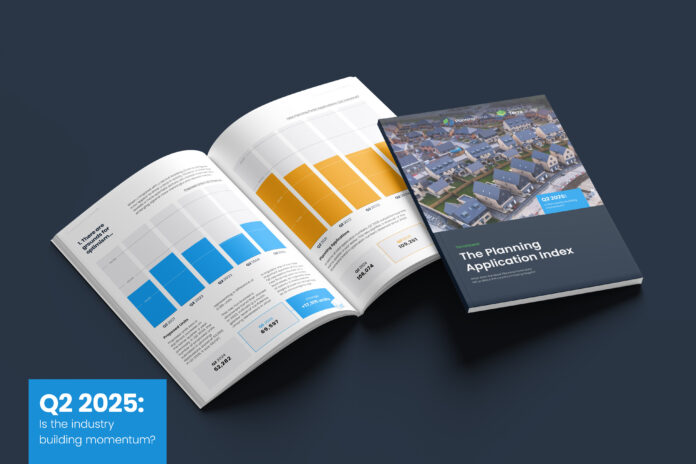New figures provide a promising snapshot of planning activity in England, revealing that new home applications increased by nearly a third between April and June 2025, compared to the same period in 2024. The data, from Planning Portal operator TerraQuest, will be welcomed by ministers as they push forward with reforms aimed at delivering 1.5 million new homes by the end of the current parliamentary term.
These figures were revealed in the latest Planning Portal Application Index for Q2 2025, which covers 95% of the planning applications made to local authorities in England. The report shows 69,597 new homes were applied for during Q2, up from 52,282 during the same period a year earlier.
In further good news for the sector, seven out of eight regions saw more new homes applied for in Q2 of 2025 than in Q2 of 2024, with the West Midlands seeing especially strong growth of 71.7%.

Geoff Keal, CEO at TerraQuest, operator of Planning Portal, said: “There are clear signs of sector recovery, with our data revealing a notable rise in planning activity, contrasting with some of the less positive trends reported further along the development cycle, such as in construction. Because our data captures the very first step in the planning journey – often months before work begins on site – it provides a reliable early indicator of market sentiment. The recent uplift points to growing confidence among developers and housebuilders, likely driven by positive policy signals, including the revised National Planning Policy Framework (NPPF) and the Planning and Infrastructure Bill currently progressing through the House of Lords.
“While the figures don’t yet align with the government’s target of 1.5 million homes, they do show a clear uptick in the planning pipeline. This growth signals renewed market intent, as the sector lays foundations for increased activity while planning reforms take time to bed in.”
Planning and property experts weigh in on the application surge, its reflection in their work, and the impact of recent policy changes:
“We’re seeing an increase in planning and housing applications, especially in areas where Local Plans are under review or recently withdrawn. The December 2024 updates to the NPPF, including a softer housing delivery test and clearer support for brownfield development, have encouraged more speculative and strategic submissions. Developers also appear to be acting ahead of possible policy tightening in late 2025.
“There may also be pent-up demand following a subdued period post-COVID and earlier plan-making uncertainty. The revised NPPF’s more flexible approach to the five-year housing land supply has lowered risks for developers, making it more attractive to bring forward sites now.
“We’re noticing more pre-application engagement and design-led discussions, a positive sign of confidence. However, delivery remains patchy, with Build to Rent and strategic land sectors most responsive, particularly in urban extensions and regeneration areas with existing infrastructure.
Persistent challenges include delays in signing S106 agreements, nutrient and water neutrality requirements causing local delays, capacity issues within planning authorities slowing determinations, and infrastructure funding gaps limiting readiness.
“While some issues like nutrient neutrality delays are easing due to new mitigation strategies, new challenges have arisen from mandatory biodiversity net gain requirements and the Building Safety Act/Gateway process — both positive in principle but currently adding uncertainty, longer programmes, and increased costs.”
- Mary-Jane O’Neill, Head of Planning Consultancy (London & South), Planning, Regeneration + Infrastructure, Lambert Smith Hampton
“Whilst new homes are the government’s focus, we’ve seen more than double the enquiry volumes across homeowner products this year – particularly for conversions, extensions, and other improvement works. The shift began tentatively in Q1 and has picked up pace as inflationary pressures ease and interest rate expectations stabilise.
“It’s encouraging, but not unexpected. Underlying demand for housing never disappeared, developers and homeowners alike were simply holding off amid uncertainty. What we’re seeing now is cautious re-engagement. There are green shoots, although delivery still lags behind. Construction costs remain a key friction point, and planning bottlenecks persist in some local authorities, especially those still grappling with post-COVID staffing challenges.
“Interestingly, we’re seeing fewer delays around funding approvals, which is a positive change from this time last year. And there’s strong interest in commuter-belt projects, particularly where there’s a clear housing need and good transport links.
“Second charge mortgage applications for home improvements have more than doubled year-on-year. For many, improving an existing property has become more cost-effective than moving, especially with high house prices and limited stock. A second charge loan allows homeowners to unlock equity without affecting their existing mortgage – and that’s proving a smart route for those looking to adapt their homes to suit lifestyle needs.
“If current sentiment holds, we expect steady but measured growth over the next 6–12 months. Confidence is returning.”




